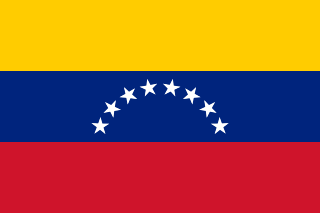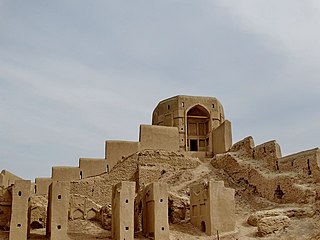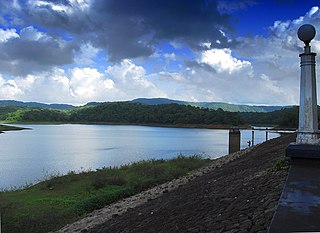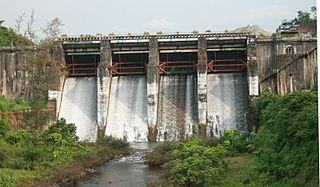Related Research Articles

Venezuela, officially the Bolivarian Republic of Venezuela, is a country on the northern coast of South America, consisting of a continental landmass and many islands and islets in the Caribbean Sea. It has a territorial extension of 916,445 km2 (353,841 sq mi), and its population was estimated at 29 million in 2022. The capital and largest urban agglomeration is the city of Caracas.

Irrigation is the practice of applying controlled amounts of water to land to help grow crops, landscape plants, and lawns. Irrigation has been a key aspect of agriculture for over 5,000 years and has been developed by many cultures around the world. Irrigation helps to grow crops, maintain landscapes, and revegetate disturbed soils in dry areas and during times of below-average rainfall. In addition to these uses, irrigation is also employed to protect crops from frost, suppress weed growth in grain fields, and prevent soil consolidation. It is also used to cool livestock, reduce dust, dispose of sewage, and support mining operations. Drainage, which involves the removal of surface and sub-surface water from a given location, is often studied in conjunction with irrigation.

Zabol is a city in, and the capital of, the Central District of Zabol County, Sistan and Baluchestan province, Iran, and also serves as capital of the county. Zabol is near the border with Afghanistan. Referred to as Sistan until the late 1920s, the city was renamed Zabol by Reza Shah Pahlavi.

Lake Valencia, formerly Lake Tacarigua, is a lake within Carabobo State and Aragua State in northern Venezuela.

The Ord River is a 651-kilometre long (405 mi) river in the Kimberley region of Western Australia. The river's catchment covers 55,100 square kilometres (21,274 sq mi).

The Hrazdan is a major river and the second largest in Armenia. It originates at the northwest extremity of Lake Sevan and flows south through the Kotayk Province and Armenia's capital, Yerevan; the lake in turn is fed by several streams. In the Ararat plain it joins the Aras river along the border with Turkey. Its waters join the Kura river, before flowing into the Caspian Sea.
The Balimela Reservoir is located in Malkangiri district, Odisha, India on the river Sileru which is a tributary of the Godavari river. The gross storage capacity of Balimela reservoir is 3610 million cubic meters.

Calabozo, officially Villa de Todos los Santos de Calabozo, is a city in Venezuela located in the Guárico state, capital of the Francisco de Miranda Municipality and former capital of the state. It has a population of 168,605, according to the National Institute of Statistics (INE) in 2020. It is located in the center-west of Guárico state, and is one of the main rice producers in the country. In addition, it has the largest irrigation system in Venezuela.


The Kurrama River, or Kurram River, originates from watershed of Spin Ghar in the Paktia Province of Afghanistan and the Kurram District of Pakistan, flows through North Waziristan and Khyber Pakhtunkhwa, passing through the city of Bannu, and then joins the Indus River near Isa Khel. It drains the southern flanks of the Spin Ghar mountain range and is a right bank tributary of the Indus River.

River Vamsadhara or River Banshadhara is an important east flowing river between Rushikulya and Godavari, in Odisha and Andhra Pradesh states in India.
Kanuru Lakshmana Rao was an Indian Civil engineer and a Padma Bhushan awardee who served as the Union Minister of Irrigation & Power and Member of Parliament for Vijayawada from 1962 to 1977.

The Aragua River is a South America river in Aragua State, Venezuela. The river flows from the northern part of the state into the endorheic Lake Valencia, and is the lake's main tributary.

Timoto–Cuica people were an indigenous people of the Americas composed primarily of two large tribes, the Timote and the Cuica, that inhabited in the Andes region of Western Venezuela. They were closely related to the Muisca people of the Colombian Andes, who spoke Muysccubun, a version of Chibcha. The Timoto-Cuicas were not only composed of the Timote and the Cuica groups, but also of smaller tribes including the Mucuchíes, the Miguríes, the Tabayes and the Mucuñuques.

Indigenous people in Venezuela, Amerindians or Native Venezuelans, form about 2% of the total population of Venezuela, although many Venezuelans are mixed with Indigenous ancestry. Indigenous people are concentrated in the Southern Amazon rainforest state of Amazonas, where they make up nearly 50% of the population and in the Andes of the western state of Zulia. The most numerous indigenous people, at about 200,000, is the Venezuelan part of the Wayuu people who primarily live in Zulia between Lake Maracaibo and the Colombian border. Another 100,000 or so indigenous people live in the sparsely populated southeastern states of Amazonas, Bolívar and Delta Amacuro.

Vazhani Dam is a clay dam built across the Wadakkancherry river near Wadakkancherry in Thrissur district of Kerala. The water is used for irrigation and drinking purposes. The dam has a four-acre garden and the construction was completed in 1962. Vazhani dam is built with mud and it is an earth dam like Banasura Sagar Dam

Irrigation in India includes a network of major and minor canals from Indian rivers, groundwater well based systems, tanks, and other rainwater harvesting projects for agricultural activities. Of these groundwater system is the largest. In 2013–14, only about 36.7% of total agricultural land in India was reliably irrigated, and remaining 2/3 cultivated land in India is dependent on monsoons. 65% of the irrigation in India is from groundwater. Currently about 51% of the agricultural area cultivating food grains is covered by irrigation. The rest of the area is dependent on rainfall which is most of the times unreliable and unpredictable.
Hafiz Mohamad Ibrahim, also spelled as Hafiz Muhammad Ibrahim (1889-1968), was a leader of Indian National Congress. He was governor of Punjab, India in 1965. Ibrahim was a member of Rajya Sabha from 1958 to 1962 and served as union minister of power and irrigation. He was leader of the Rajya Sabbha from 1961 to 1963. He served as Communication and Irrigation minister for United Provinces (1937–50).

Peruvannamuzhi dam, also known as Kuttiady (Id) Dam, is a dam built on the Kuttiady River at Peruvannamuzhi in Chakkittapara Grama Panchayath in Kozhikode district, Kerala. It is 16 km away from Kuttiady town and it is 55 km from Kozhikode town. It was constructed as part of the Kuttiady irrigation project. The project consists of a masonry dam across Kuttiyady River and 13 earth dams to maximize the storage of the reservoir. The construction of this project started in 1962 and was commissioned in 1973.
References
- ↑ The New International Atlas (13 ed.). Chicago: Rand McNally. 1993. ISBN 0528835483.
- ↑ Venezuela Up-to-date. Embassy of Venezuela. 1962. p. 6. Retrieved 3 May 2022.